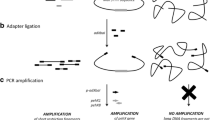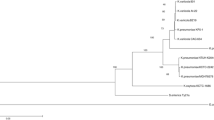Abstract
Klebsiella pneumoniae belongs to Enterobacteriaceae, which is the commonest bacterium causing nosocomial respiratory tract infection. It ranks second in bacteremia and urinary tract infection in gram-negative bacteria. Therefore, the rapid and accurate identification of K. pneumoniae was of great significance for the guide of clinical medication, and timely treatment of patients. The purpose of this study was to establish a rapid and sensitive molecular detection method for K. pneumoniae based on loop-mediated isothermal amplification (LAMP) technology. Firstly, local BLAST and NCBI BLAST were used to analyze the genome of K. pneumoniae. According to the principle of interspecific and intraspecific specificity, CelB (GenBank ID 11847805) was selected as the specific gene. Then, the LAMP and PCR identification systems were established with this target gene. Thirty-six clinical isolates of K. pneumoniae and 50 non-K. pneumoniae were used for the specific evaluation, and both LAMP and PCR could specifically distinguish K. pneumoniae from non-K. pneumoniae. A 10-fold series diluted positive plasmids and simulated infected blood samples were used as the templates in the sensitivity assay, and the results showed that the sensitivity could reach 1 copy/reaction. In summary, a rapid, specific, and sensitive LAMP method was established to detect K. pneumoniae in clinics.


Similar content being viewed by others
References
Khaertynov KS, Anokhin VA, Rizvanov AA, Davidyuk YN, Semyenova DR, Lubin SA, Skvortsova NN (2018) Virulence factors and antibiotic resistance of Klebsiella pneumoniae strains isolated from neonates with sepsis. Front Med (Lausanne) 5:225. https://doi.org/10.3389/fmed.2018.00225
Lin YT, Tseng KY, Yeh YC, Yang FC, Fung CP, Chen NJ (2014) TREM-1 promotes survival during Klebsiella pneumoniae liver abscess in mice. Infect Immun 82(3):1335–1342. https://doi.org/10.1128/IAI.01347-13
Rock C, Thom KA, Masnick M, Johnson JK, Harris AD, Morgan DJ (2014) Frequency of Klebsiella pneumoniae carbapenemase (KPC)-producing and non-KPC-producing Klebsiella species contamination of healthcare workers and the environment. Infect Control Hosp Epidemiol 35(4):426–429. https://doi.org/10.1086/675598
Kobayashi SD, Porter AR, Freedman B, Pandey R, Chen L, Kreiswirth BN, DeLeo FR (2018) Antibody-mediated killing of carbapenem-resistant ST258 Klebsiella pneumoniae by human neutrophils. mBio 9(2). https://doi.org/10.1128/mBio.00297-18
Lin WH, Tseng CC, Wu AB, Yang DC, Cheng SW, Wang MC, Wu JJ (2015) Clinical and microbiological characteristics of peritoneal dialysis-related peritonitis caused by Klebsiella pneumoniae in southern Taiwan. J Microbiol Immunol Infect 48(3):276–283. https://doi.org/10.1016/j.jmii.2013.10.002
Long SW, Olsen RJ, Eagar TN, Beres SB, Zhao P, Davis JJ, Brettin T, Xia F, Musser JM (2017) Population genomic analysis of 1,777 extended-Spectrum Beta-lactamase-producing Klebsiella pneumoniae isolates, Houston, Texas: unexpected abundance of clonal group 307. mBio 8(3). https://doi.org/10.1128/mBio.00489-17
Bachman MA, Breen P, Deornellas V, Mu Q, Zhao L, Wu W, Cavalcoli JD, Mobley HL (2015) Genome-wide identification of Klebsiella pneumoniae fitness genes during lung infection. mBio 6(3):e00775. https://doi.org/10.1128/mBio.00775-15
Barreda-Garcia S, Miranda-Castro R, de-Los-Santos-Alvarez N, Miranda-Ordieres AJ, Lobo-Castanon MJ (2018) Helicase-dependent isothermal amplification: a novel tool in the development of molecular-based analytical systems for rapid pathogen detection. Anal Bioanal Chem 410(3):679–693. https://doi.org/10.1007/s00216-017-0620-3
Mekata T, Kono T, Savan R, Sakai M, Kasornchandra J, Yoshida T, Itami T (2006) Detection of yellow head virus in shrimp by loop-mediated isothermal amplification (LAMP). J Virol Methods 135(2):151–156. https://doi.org/10.1016/j.jviromet.2006.02.012
Meserve D, Wang Z, Zhang DD, Wong PK (2008) A double-stranded molecular probe for homogeneous nucleic acid analysis. Analyst 133(8):1013–1019. https://doi.org/10.1039/b804853c
Zhu G, Ye X, Dong Z, Lu YC, Sun Y, Liu Y, McCormack R, Gu Y, Liu X (2015) Highly sensitive droplet digital PCR method for detection of EGFR-activating mutations in plasma cell-free DNA from patients with advanced non-small cell lung cancer. J Mol Diagn 17(3):265–272. https://doi.org/10.1016/j.jmoldx.2015.01.004
Mullis K, Faloona F, Scharf S, Saiki R, Horn G, Erlich H (1992) Specific enzymatic amplification of DNA in vitro: the polymerase chain reaction. 1986. Biotechnology 24:17–27
Notomi T, Okayama H, Masubuchi H, Yonekawa T, Watanabe K, Amino N, Hase T (2000) Loop-mediated isothermal amplification of DNA. Nucleic Acids Res 28(12):E63
Caipang CM, Haraguchi I, Ohira T, Hirono I, Aoki T (2004) Rapid detection of a fish iridovirus using loop-mediated isothermal amplification (LAMP). J Virol Methods 121(2):155–161. https://doi.org/10.1016/j.jviromet.2004.06.011
Kang SI, Her M, Kim JY, Lee JJ, Lee K, Sung SR, Jung SC (2015) Rapid and specific identification of Brucella abortus using the loop-mediated isothermal amplification (LAMP) assay. Comp Immunol Microbiol Infect Dis 40:1–6. https://doi.org/10.1016/j.cimid.2015.03.001
Ptaszynska AA, Borsuk G, Wozniakowski G, Gnat S, Malek W (2014) Loop-mediated isothermal amplification (LAMP) assays for rapid detection and differentiation of Nosema apis and N. ceranae in honeybees. FEMS Microbiol Lett 357(1):40–48. https://doi.org/10.1111/1574-6968.12521
Rodel J, Bohnert JA, Stoll S, Wassill L, Edel B, Karrasch M, Loffler B, Pfister W (2017) Evaluation of loop-mediated isothermal amplification for the rapid identification of bacteria and resistance determinants in positive blood cultures. Eur J Clin Microbiol Infect Dis 36(6):1033–1040. https://doi.org/10.1007/s10096-016-2888-1
Soliman H, Saleh M, El-Matbouli M (2015) Detection of fish pathogens by loop-mediated isothermal amplification (LAMP) technique. Methods in Molecular Biology (Clifton, NJ) 1247:163–173. https://doi.org/10.1007/978-1-4939-2004-4_12
Martins KB, Ferreira AM, Mondelli AL, Rocchetti TT, Lr d SCM (2018) Evaluation of MALDI-TOF VITEK((R))MS and VITEK((R)) 2 system for the identification of Staphylococcus saprophyticus. Future Microbiol 13:1603–1609. https://doi.org/10.2217/fmb-2018-0195
Sarier M, Sepin N, Duman I, Demir M, Hizel A, Goktas S, Emek M, Kukul E, Soylu A (2018) Microscopy of Gram-stained urethral smear in the diagnosis of urethritis: which threshold value should be selected? Andrologia 50(10):e13143. https://doi.org/10.1111/and.13143
Li C, Shi Y, Yang G, X-s X, Mao X, Fang Y, Zhang A-M, Song Y (2019) Establishment of loop-mediated isothermal amplification for rapid detection of Pseudomonas aeruginosa. Experimental and Therapeutic Medicine 17:6. https://doi.org/10.3892/etm.2018.6910
Li C, Shi YQ, Yang GY, Xia XS, Mao XQ, Fang Y, Zhang AM, Song YZ (2019) Loop-mediated isothermal amplification assay for rapid detection of hypothetical protein gene in Escherichia coli clinical isolates. Clin Lab 65(4). https://doi.org/10.7754/Clin.Lab.2018.180826
Ferkol T, Schraufnagel D (2014) The global burden of respiratory disease. Annals of the American Thoracic Society 11(3):404–406. https://doi.org/10.1513/AnnalsATS.201311-405PS
Miriagou V, Cornaglia G, Edelstein M, Galani I, Giske CG, Gniadkowski M, Malamou-Lada E, Martinez-Martinez L, Navarro F, Nordmann P, Peixe L, Pournaras S, Rossolini GM, Tsakris A, Vatopoulos A, Canton R (2010) Acquired carbapenemases in gram-negative bacterial pathogens: detection and surveillance issues. Clinical Microbiology and Infection: the Official Publication of the European Society of Clinical Microbiology and Infectious Diseases 16(2):112–122. https://doi.org/10.1111/j.1469-0691.2009.03116.x
Queenan AM, Bush K (2007) Carbapenemases: the versatile beta-lactamases. Clin Microbiol Rev 20(3):440–458, table of contents. https://doi.org/10.1128/CMR.00001-07
Bharathi MJ, Murugan N, Rameshkumar G, Ramakrishnan R, Venugopal Reddy YC, Shivkumar C, Ramesh S (2013) Comparative evaluation of uniplex, nested, semi-nested, multiplex and nested multiplex PCR methods in the identification of microbial etiology of clinically suspected infectious endophthalmitis. Curr Eye Res 38(5):550–562. https://doi.org/10.3109/02713683.2013.772205
Teranishi H, Ohzono N, Inamura N, Kato A, Wakabayashi T, Akaike H, Terada K, Ouchi K (2015) Detection of bacteria and fungi in blood of patients with febrile neutropenia by real-time PCR with universal primers and probes. J Infect Chemother 21(3):189–193. https://doi.org/10.1016/j.jiac.2014.11.008
Ohtsuka K, Yanagawa K, Takatori K, Hara-Kudo Y (2005) Detection of Salmonella enterica in naturally contaminated liquid eggs by loop-mediated isothermal amplification, and characterization of Salmonella isolates. Appl Environ Microbiol 71(11):6730–6735. https://doi.org/10.1128/AEM.71.11.6730-6735.2005
Abdoli A, Dalimi A, Soltanghoraee H, Ghaffarifar F (2016) Molecular detection of toxoplasma gondii in house sparrow (Passer domesticus) by LAMP and PCR methods in Tehran, Iran. J Parasit Dis 40(4):1317–1321. https://doi.org/10.1007/s12639-015-0680-2
Dong D, Liu W, Li H, Wang Y, Li X, Zou D, Yang Z, Huang S, Zhou D, Huang L, Yuan J (2015) Survey and rapid detection of Klebsiella pneumoniae in clinical samples targeting the rcsA gene in Beijing, China. Front Microbiol 6:519. https://doi.org/10.3389/fmicb.2015.00519
Kitamura M, Aragane M, Nakamura K, Watanabe K, Sasaki Y (2017) Rapid identification of drug-type strains in Cannabis sativa using loop-mediated isothermal amplification assay. J Nat Med 71(1):86–95. https://doi.org/10.1007/s11418-016-1031-z
Acknowledgments
The authors would like to express their sincere gratitude to Mr. Yaoqiang Shi for his help in the language of the article.
Funding
This work was supported by grants from Yunnan Science and Technology Commission (2015BC001 and 2015DH010).
Author information
Authors and Affiliations
Corresponding authors
Ethics declarations
Conflict of interest
The authors declare that they have no competing interests.
Additional information
Responsible Editor: Elizabeth Andrade Marques.
Publisher’s note
Springer Nature remains neutral with regard to jurisdictional claims in published maps and institutional affiliations.
Rights and permissions
About this article
Cite this article
Tian, Y., Wang, L., Zhang, J. et al. CelB is a suitable marker for rapid and specific identification of Klebsiella pneumoniae by the loop-mediated isothermal amplification (LAMP) assay. Braz J Microbiol 50, 961–967 (2019). https://doi.org/10.1007/s42770-019-00144-9
Received:
Accepted:
Published:
Issue Date:
DOI: https://doi.org/10.1007/s42770-019-00144-9




